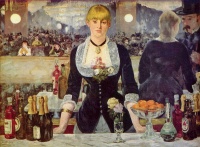Demimonde
From The Art and Popular Culture Encyclopedia
| Revision as of 19:48, 25 December 2008 Jahsonic (Talk | contribs) ← Previous diff |
Revision as of 19:48, 25 December 2008 Jahsonic (Talk | contribs) Next diff → |
||
| Line 3: | Line 3: | ||
| {{Template}} | {{Template}} | ||
| - | # A [[class]] of [[women]] kept by [[wealthy]] [[protector]]s; [[female]] [[prostitute]]s as a group | + | # A [[class]] of [[women]] kept by [[wealthy]] [[protector]]s; [[female prostitute]]s as a group |
| # A group having little [[respect]] or [[reputation]] | # A group having little [[respect]] or [[reputation]] | ||
Revision as of 19:48, 25 December 2008


|
Related e |
|
Featured: |
- A class of women kept by wealthy protectors; female prostitutes as a group
- A group having little respect or reputation
Demimonde (French for "half-world") is a polite 19th century term that was often used the same way we use the term "mistress" today. In the 19th century, however, it primarily referred to a class of women on the fringes of respectable society supported by wealthy lovers (usually each had several). The term is also used to refer to these women as a group, and the social circles they moved in. As a group, the demimonde did not form a 'society', per-se, any more than modern prostitutes form a society. However, they did represent a specific class of women in the latter half of the 19th century and into the early 20th century who, though not respectable, were commonplace fixtures in the upper class of French, English and, to some extent, American society. In the United States and Britain, they were (and still are) also often referred to as courtesans, though the term courtesan in the 19th century applied to a profession (as the term "prostitute" describes a profession), whereas Demimonde/Demimondaine was used to describe a broader social class of persons. The term is French, and means literally "half-world", implying those who existed on the fringes of the "real world."
Fictional demimonde
Descriptions of the demimonde can be found in Vanity Fair by William Makepeace Thackeray and Colette's Gigi
Real demimonde
Externally, the defining aspects of the demimonde were an extravagant lifestyle of fine food and fine clothes, easily surpassing that of most other wealthy women of their day, simply because of the steady income they made in both cash and gifts from their various lovers. Internally, however, their lifestyle was an eclectic mixture of sharp business acumen, social skills, and simple hedonism. Smart demimondaine, like the fictional Gigi's grandmother, invested their wealth for the day when their beauty would finally fade. Others ended up penniless and starving when age finally took its toll on their beauty unless they managed to marry one of their lovers. Of real-life demimonde, the most famous was arguably Cora Pearl.
Decline of the demimonde
As the 20th century dawned, evolving social mores regarding women's place in society (particularly the suffragette and flapper movements) caused the demimonde to fade. The term then became commonly used to refer to the class of 'starving artists' - painters, authors, poets and other pseudo-bohemian types - who were marginalized by their failure to succeed financially.

